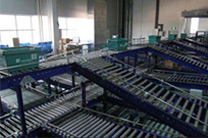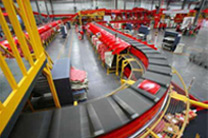The automatic sorting system is generally composed of control device, classification device, conveying device and sorting crossing.
1. The function of the control device is to identify, receive and process the sorting signal, instruct the classification device according to the requirements of the sorting signal, and automatically classify the commodities according to the commodity variety, the commodity delivery place or the category of the owner. These sorting requirements can be input into the sorting control system in different ways, such as bar code scanning, color code scanning, keyboard input, weight detection, voice recognition, height detection, shape recognition, etc. according to the judgment of these sorting signals, it can determine which sorting crossing a certain commodity should enter.
2. The function of the sorting device is to change the running direction on the conveying device to enter other conveyors or sorting crossings when commodities with the same sorting signal pass through the device according to the sorting instructions sent by the control device. There are many types of sorting devices, generally including push-out type, floating type, inclined type and branch type. Different devices have different requirements for the packaging materials, packaging weight and the smoothness of the bottom surface of the packages.
3. The main component of the conveying device is the conveyor belt or conveyor, which is mainly used to make the commodities to be sorted pass through the control device and classification device, and the two sides of the conveying device are generally connected with several sorting crossings, so that the classified commodities can slide down the main conveyor (or main conveyor belt) for subsequent operations.
4. The sorting crossing is a channel for the sorted goods to leave the main conveyor (or main conveyor belt) and enter the goods collection area. Generally, it consists of steel belts, belts, rollers, etc., so that the goods can slide from the main conveyor to the goods collection platform, where the staff can collect all the goods at the crossing, or store them in the warehouse, or assemble and load vehicles for distribution.
The above four parts of devices are connected together through computer network, and cooperate with manual control and corresponding manual processing links to form a complete automatic sorting system.
|
The automatic sorting system has the following features
1. It can sort goods continuously and in large quantities. Due to the automatic operation mode of assembly line used in mass production, the automatic sorting system is not limited by climate, time, human physical strength, etc., and can operate continuously. At the same time, due to the large number of pieces sorted by the automatic sorting system per unit time, the sorting capacity of the automatic sorting system is to operate continuously for more than 100 hours, and 7000 packaged goods can be sorted per hour. If manual work is used, only about 150 pieces can be sorted per hour, At the same time, the sorting personnel cannot work continuously for 8 hours under this labor intensity.
2. The sorting error rate is very low. The sorting error rate of the automatic sorting system mainly depends on the accuracy of the input sorting information, which in turn depends on the input mechanism of the sorting information. If the manual keyboard or voice recognition mode is used for input, the error rate will be more than 3%. If the barcode scanning input is used, there will be no error unless there is an error in the barcode printing itself. Therefore, the current automatic sorting system mainly uses bar code technology to identify goods.
3. The sorting operation is basically unmanned. One of the purposes of establishing automatic sorting system abroad is to reduce the use of personnel, reduce the labor intensity of workers and improve the efficiency of personnel. Therefore, automatic sorting system can minimize the use of personnel and basically achieve unmanned.
|
|
|






